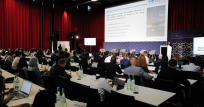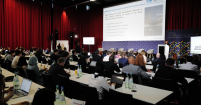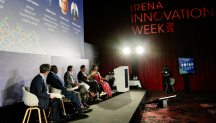

Innovation Week 2025 As It Happens - Day 3
Newsletter
IRENA Innovation Week brings leaders, experts, industry representatives, academia, youth and policymakers together to explore cutting-edge innovations that can drive the global energy transition and advance sustainable development, enabled by renewable energy and digitalisation technologies.
The 2025 edition focuses on two aspects: Innovation in infrastructure for tripling renewables and Renewable-based solutions for sustainable development.
Day 3 sessions on Innovation in infrastructure for tripling renewables
Enabling next generation trade in renewable energy value chains

Co-organised by IRENA and the Organization for Economic Cooperation and Development (OECD), this session explores how emerging trade patterns in renewable energy and hydrogen markets are reshaping global energy commerce as countries adapt to climate imperatives and evolving geopolitical circumstances. The energy transition is creating new paradigms where countries with abundant renewable resources emerge as exporters of renewable power, biofuels, and hydrogen derivatives, while nations with strong industrial sectors but limited resources increasingly rely on imports to decarbonise their energy systems.
Exploring how the energy transition will fundamentally reshape global trade dynamics and forge entirely new trading patterns, Ann-Kathrin Lipponer, IRENA, said, "We need to make sure that new value chains are not only sustainable but also resilient and cost-competitive," during here scene-setting presentation. She emphasised that enabling measures for these emerging value chains should be built on three essential pillars: infrastructure, institutional frameworks, and social considerations.
In his scene-setting presentation, Deger Saygin, OECD, revealed projections for the global hydrogen market, forecasting growth to 30 million tonnes by 2040, driven primarily through ammonia. However, uncertainties surrounding demand and price projections are increasing risks for hydrogen projects and creating financing challenges. To overcome these barriers, effective de-risking strategies must deploy targeted instruments such as guarantees and Contracts for Difference, combined with strategic public-private partnerships that balances risk-return profiles and unlock large-scale investment.
The panel highlighted that international hydrogen trade currently operates as a buyers' market, compelling producing countries to adhere to the diverse and complex regulations of importing nations. To unlock this market's potential, robust financial frameworks, unified standards, and streamlined certification processes are indispensable. International cooperation emerges as the cornerstone for success, as Eleanor Webster, Mission Innovation, emphasised, "International cooperation is essential for reducing risks in cross-border markets. You can't do that without speaking to each other." This collaboration focuses on reducing cross-border risks, building trust between stakeholders, pooling R&D resources, and co-developing critical infrastructure, ultimately working to harmonise trade rules and foster global networks. Ultimately, regulatory certainty is necessary to stimulate investments in hydrogen infrastructure, as the ongoing uncertainty surrounding potential regulatory changes significantly slows down project development and market growth.
The fireside chat featured insights from Chenjiang Xiao from the China Hydrogen Alliance and Luca Corradi from the Net Zero Technology Centre, focusing on real-world developments in the next-generation hydrogen economy. Chenjiang Xiao highlighted China's remarkable technological breakthroughs in electrolysers and diverse hydrogen production pathways, establishing China as a significant contributor in global hydrogen technology advancement and cost reduction.
Meanwhile, Luca Corradi presented the Net Zero Technology Centre's pioneering work on transporting hydrogen from Scotland's extensive offshore wind resources to Germany. Their studies reveal that a new, purpose-built pipeline offers the most cost-effective solution, positioning Scottish hydrogen as highly competitive. While much of the required infrastructure technology has reached maturity, additional R&D remains essential for large-scale compressors and calibrated hydrogen meters. Both speakers emphasised how technological innovation, infrastructure development, and international collaboration are vital for accelerating the global hydrogen economy and energy transition.
The closing remarks for this session underscored that international collaboration and coordination are crucial for building confidence and improving investment conditions in the evolving hydrogen market. This cooperation aims to bring producers and consumers together to align requirements, shape suitable international markets, and manage financing, offtake, and trade rules.
Infrastructure for sustainable fuels for shipping and aviation

This session explores critical infrastructure developments needed to scale sustainable fuels across aviation and maritime shipping sectors, which together account for 5-6% of global greenhouse gas emissions and face potential doubling of activity by 2050. Ports and airports are switching to cleaner fuels like biofuels, green e-fuels, and renewable electricity, which requires updating existing infrastructure and building new systems to store, transport, and supply these fuels.
In his scene-setting presentation, Peter Schniering, Future Cleantech Architects, discussed the significant climate challenges and decarbonisation efforts within the shipping and aviation sectors. He highlighted that 40% of international shipping cargo by weight is fossil fuels, and shipping contributes 2% of global energy-related carbon dioxide (CO₂) emissions, while aviation accounts for 2.5% of emissions with significant non-CO₂. effects. Both sectors face urgency due to long asset lifespans, with decarbonisation in aviation explored through electric, hydrogen, and Sustainable Aviation Fuels for varying flight ranges.
The second scene-setting presentation by Arno van den Bos, IRENA, introduced four essential strategies for decarbonising the shipping and aviation sectors: improving energy efficiency, electrification, utilising biomass/biofuels, and developing hydrogen-based e-fuels. For shipping, future fuels may include ammonia, advanced biofuels, and methanol, but these options are considerably more expensive than current heavy fuel oil, and sustainable carbon sources for methanol are scarce. While aviation's fuel discussion is similar, it excludes ammonia and focuses on e-kerosene and biofuels, with the global transport of hydrogen derivatives like ammonia and methanol also impacting shipping infrastructure.
In the final scene-setting presentation, Zhang Chang, Huaneng Clean Energy Research Institute, shared insights on China's green hydrogen status and trends, emphasising its vital role in decarbonising hard-to-electrify transportation sectors like aviation and shipping through e-fuels such as ammonia and methanol. Green hydrogen production capacity is increasing driven by national carbon goals and supportive policies, but challenges remain in achieving stable and low-cost supply, which is crucial for the overall cost and green attribute of these fuels. Future development focuses on integrating green hydrogen production with renewable energy sources, along with continuous efforts in cost reduction and green certification.
The panel discussion focused on the multifaceted challenges and pathways for decarbonising the shipping and aviation sectors using green fuels, such as ammonia, methanol, and Sustainable Aviation Fuels (SAFs). The panellists highlighted key challenges, including the immense infrastructure investments required for the transport and distribution of new fuels, particularly for shipping where port specialization and safety concerns with substances like ammonia are critical. As Pierpaolo from the European Transport and Energy Research Center emphasised, "Besides transport, storage, compression and liquefaction, safety and costs are key concerns for decarbonization of maritime shipping with alternative fuels like ammonia, and methanol. In shipping sector, a revolution is needed regarding renewable fuels."
For aviation, the difficulties lie in securing sufficient and sustainable feedstocks, streamlining complex global certification processes, and overcoming high production costs. Ralph-Uwe Dietrich, German Aerospace Center (DLR) underscored the regulatory complexity, stating, "Regulation needs to be streamlined, simplified, and reflecting exactly the environmental benefits that we want to achieve." Overarching issues for both sectors include the need to ramp up green fuel production, attract significant financial investment, establish clear and consistent global standards, and implement effective market mechanisms to drive demand and manage high premiums.
The panel concluded by exploring visions for the future, which will likely see short-distance electrification and the use of e-fuels for long-distance transport, underscoring that all decarbonisation pathways are necessary.
Day 3 sessions on Renewables-based solutions for sustainable development
Innovative business models for bioenergy in the Global South

This session explores how innovative bioenergy business models are unlocking solutions to the Global South's urgent energy demands and ambitious decarbonisation targets, while driving the scale-up of sustainable energy infrastructure.
Ricardo Gorini, IRENA, opened with a scene-setting presentation, beginning with a statement that without bioenergy, keeping global temperature rise below 1.5°C is not possible to achieve. He highlighted an innovative ethanol production project from Brazil that demonstrated remarkable dual impact. The project advanced technology penetration while generating significant social benefits through job creation and enhanced labour practices via biofuel-powered machinery. "This innovation process is not just systemic but engages all the stakeholders in the process," he said.
During his presentation, the energy transition's significant challenges were balanced against tremendous opportunities, as emphasised by Bharadwaj Kummamuru, World Bioenergy Association. He illustrated this with India as an example, where energy consumption demands coincides with dependence on imported energy and heavy reliance on coal. This creates an untapped potential for sustainable fuel development that the country has yet to fully harness.
Maria Michela Morese, UN FAO, spoke about the energy needs for the agrifood systems and how bioenergy is crucial going forward." Energy is needed on each and every step of agrifood chain, 30% of energy consumed is currently in the food systems globally," she underlined. The stakes are particularly high given that energy use generates 31% of climate-impacting emissions, while a third of all food produced is lost or wasted. In this context, deploying energy-smart solutions becomes essential to transform agrifood systems and sustainably nourish the global population. "Sustainability and efficiency are key in the entire value chain of bioenergy," she concluded, before showcasing examples of successful bioenergy projects from different countries.
The session reinforced that context is paramount when developing bioenergy solutions, as different regions across the Global South face unique challenges related to sectors, land use, and sustainability considerations that cannot be addressed through universal indicators. Success requires building complete systems that balance both supply and demand sides while fostering collaborative approaches tailored to each region's distinct characteristics and requirements.
Project facilitation in fragile countries: Navigating political risks, enabling RE investments

Experts will address the critical challenge of mobilising renewable energy investments in fragile and conflict-affected countries, where political risks have reached their highest levels in three decades.
During his scene setting presentation, Luis Munuera, UNEP, spoke about the opportunities for clean energy investment in fragile and conflict affected countries, where clean energy access can boost health, education, water supply and livelihoods. He outlined how renewables offer resilient and scalable solutions that deploy faster than alternatives while improving service safety and strengthening state legitimacy. "We need to understand better the unique challenges that are affecting investment in these countries," he continued.

The panel discussion tackles the critical challenge of minimising investment risks in fragile and conflict-affected countries. The challenges include weak infrastructure, poor revenue reliability with few options for exit, and in addition security risks. Addressing these barriers becomes essential to effectively support investors and organisations operating in these countries. The discussion is moderated by Ahmed Badr, Director Project Facilitation & Support, IRENA, who underscores how timely this panel discussion is. “Ongoing geopolitical tensions and disruptions have contributed to a heightened sense of uncertainty. This, in turn, presents significant challenges for investors, particularly in fragile, conflict-affected environments. This fragility extends beyond conflict and governance challenges, encompassing broader systemic shocks such as climate change,” he said, setting the scene for further discussion. |
The panellists discuss how they navigate the challenges in fragile and conflicted affected countries, mentioning innovative financing instruments, collaboration with stakeholders on the ground, relying on their local knowledge and help of international organization such as UN, for example, as pointed out by Linda Wamune, Energy Peace Partners. Nadiia Petruchenko, SPP Development Ukraine, underlined that working in a war zone brings enormous challenges. Both infrastructure and supply chains are unpredictable, and without international aid, it would be close to impossible to keep the lights on across the conflict-affected country.
Real risks in fragile states can only be mitigated through real improvement of material conditions on the ground, not only by protecting against perceived risks to investors' returns. Projects cannot be seen as short-term extractive opportunities. Patient and concessional finance is critical in this regard, and multilateral development banks are the key actors that must drive such investment. Innovations such as results-based financing and demand-side subsidies have also proven effective in fragile and conflict-affected states. Finally, perceived risks can be exaggerated in many cases, and local partnerships on the ground are crucial to provide a more accurate picture of risks and enable renewable project development.
Closing session: The way forward: Structural change and innovation for sustainable development

As Innovation Week 2025 comes to a close, this closing session addresses the urgent need for structural transformation to unlock sustainable development potential across the Global South, where stark investment disparities threaten an equitable energy transition.
In his rapporteur presentation, James Walker, IRENA, summarised the key messages from the sessions on innovation in infrastructure for tripling renewables. The energy transition is fundamentally driven by systemic innovation, encompassing technology, policy, and people. This requires the accelerated deployment of diverse infrastructure for power, renewable gases, and sustainable fuels. Digitalisation and AI are pivotal, offering solutions for grid management, forecasting, and anticipating maintenance, while the rapid growth of data centres presents both planning challenges and opportunities for scaling power system infrastructure. This complex shift also involves the emergence of international green commodity markets, particularly for hydrogen and its derivatives. Acknowledging that there will be no one-size-fits-all solution, renewables offer broad societal and environmental benefits beyond just decarbonisation.
Reflecting on the discussions from sessions under the theme, renewable-based solutions for sustainable development, Arina Anisie, IRENA, summarised its key messages. Discussions on the global energy transition, particularly within the Global South, underscored significant challenges in grid modernisation and energy access. The dialogue highlighted the crucial need for community engagement, local value creation through productive uses of energy, and the compatibility of renewables with community-led approaches. She also emphasised the importance of innovative financing models and regional joint industrial policies to foster job creation and homegrown solutions, alongside the vital role of bioenergy in meeting climate targets. Finally, she noted that investing in fragile and conflict-affected regions is feasible, despite often exaggerated risk perceptions, if there is a right mindset and international support.
The scene setting presentation focused on what is needed to make sure the energy transition delivers benefits for all, equally and in a just manner, as Diala Hawila, IRENA, outlined. While the global investment in renewables continues to grow, increasing by 14% per year since 2018, the investment flows are heavily concentrated towards advanced economies. Half of the world’s population currently receives only 10% of the global investment in the energy transition.
These disparities have been increasing due to perceived high risks and the fact that renewable energy has become a profit-making sector. At the same time, investment in supply chains is crucial for minimising reliance on imports and maximising socio-economic benefits. Therefore, IRENA has been advocating for the use of public resources to leverage private investment through mechanisms like risk mitigation. This approach ensures the energy transition is fair and just. It is crucial to keep energy at the centre of socio-economic development.
Africa's potential for development and industrialisation that could make Africa a global powerhouse is seen as a threat, as Fadhel Kaboub, Denison University and Global Institute for Sustainable Prosperity, explained. There is a need for a transformation in this approach, and what needs to happen to unlock this? Currently, Africa continues to fulfil a colonial role as a provider of cheap materials and workforce while remaining a consumer of industrial technologies and recipient of obsolete assembly lines and technologies delivered as development aid. However, establishing fair technology transfer mechanisms and sharing technology on equal terms could unleash Africa's potential to create a genuinely equitable and just world.

The panel discussion critically examined why investment in renewable energy disproportionately flows to the Global North. The discussion argued that persistent colonial economic structures perceive the Global South's potential as a threat, perpetuating extraction and limiting local industrialisation and innovation. This is compounded by an extractive global financial architecture, where trillions of dollars flow from the Global South to the Global North, undermining the achievement of Sustainable Development Goals.
Despite these systemic challenges, real-life examples have demonstrated that successful renewable energy deployment can occur through strong national institutions, in-house expertise, political consensus, and powerful bottom-up approaches spurred by local needs and high electricity costs. The discussion highlighted the need for fiscal incentives to foster local manufacturing and active technological learning, moving beyond mere assembly lines to genuine value creation and technology transfer.
International cooperation should embrace decolonised, co-created technologies and support structural shifts in the global financial system that level the playing field for developing nations. This includes addressing issues like currency volatility and mobilising capital for national development plans rather than just project-based financing. A fundamental shift in narrative is required for climate finance. This involves reframing it as debt cancellation and grants at scale, rather than loans and carbon markets that perpetuate debt traps and inequalities.
Ultimately, the energy transition must be inclusive and incorporate local narratives and realities to ensure no one is left behind, especially the most vulnerable communities through a bottom-up approach.
 Ana María Ramírez Tovar, an IRENA Youth Delegate, delivered a final speech at the Innovation Week 2025. "The energy transition is not merely technical; it is deeply human. It is not just about replacing fuels or increasing megawatts. It is a change in the very paradigm of energy - a shift in power, in participation, and in purpose," she said. "Transition is not just intersectional, it must be interdisciplinary, intergenerational, and interterritorial." She pointed out that if we risk designing an energy transition that enriches the small percentage of the global population, locking future generations into new dependencies. We should not miss out on the transformative potential of renewables to build more just and inclusive societies, and the energy transition should not only deliver energy but hope, dignity, and opportunity for every generation to come, she concluded. |
 In her closing remarks, Gauri Singh, Deputy Director, IRENA, acknowledged the high engagement of participants despite a shift in global mood from buoyant net-zero commitments two years prior to current geopolitical headwinds and emerging pessimism. However, strong momentum for renewable energy persists due to declining costs, increased efficiencies, socio-economic benefits, and a powerful community driving its strong business case. "Ten years from now, no one will look back and say that the energy transition was going to be easy. This period is just a small blip in the upward trajectory towards the energy system that we want to see." |

This concludes IRENA Innovation Week 2025, and check IRENA social media channels on #IIW2025.
Take a look at IRENA’s Twitter, LinkedIn and Instagram accounts and browse Innovation Week photos on IRENA Flickr.




